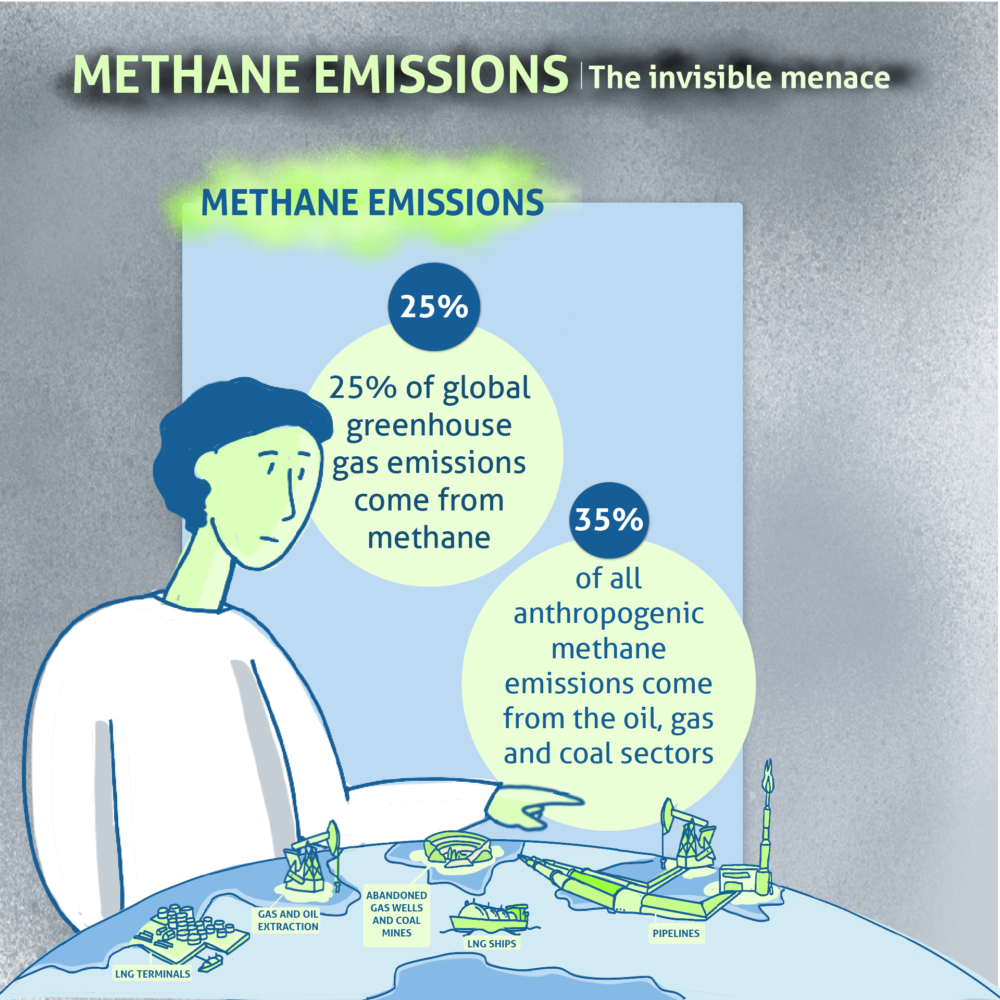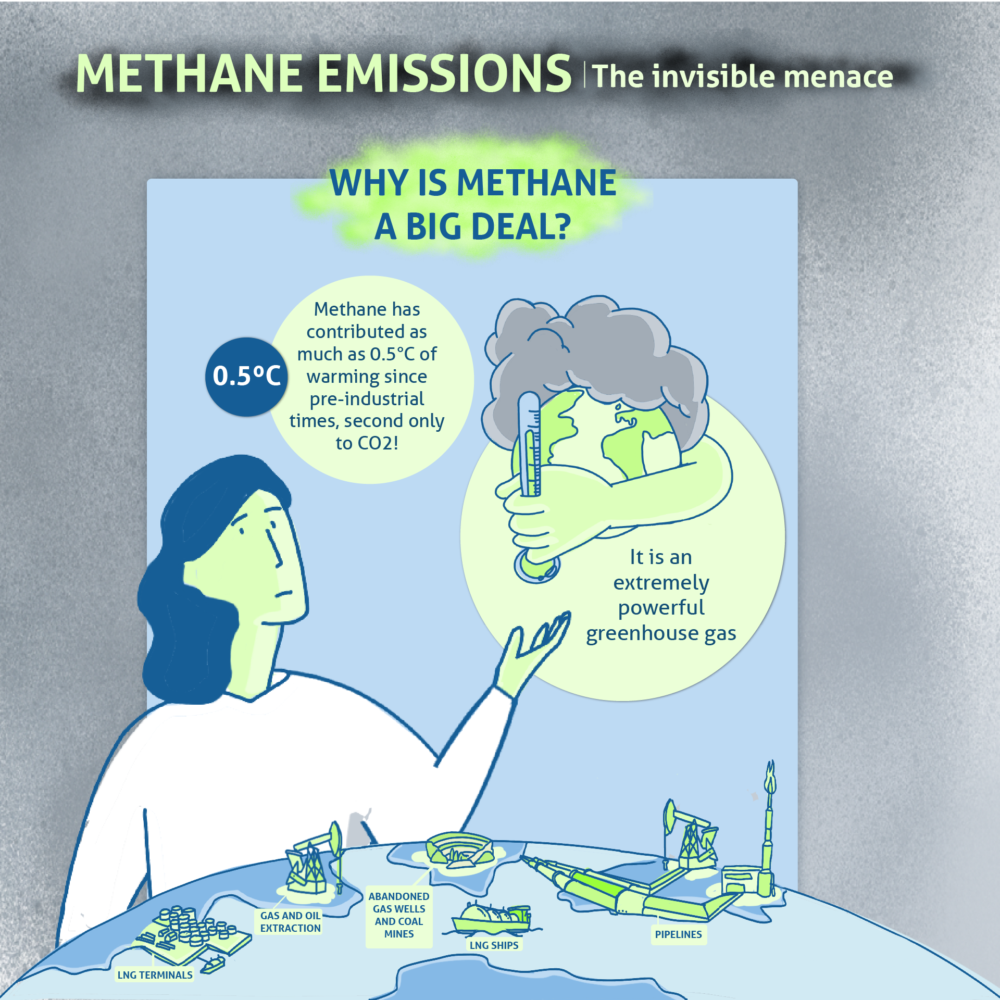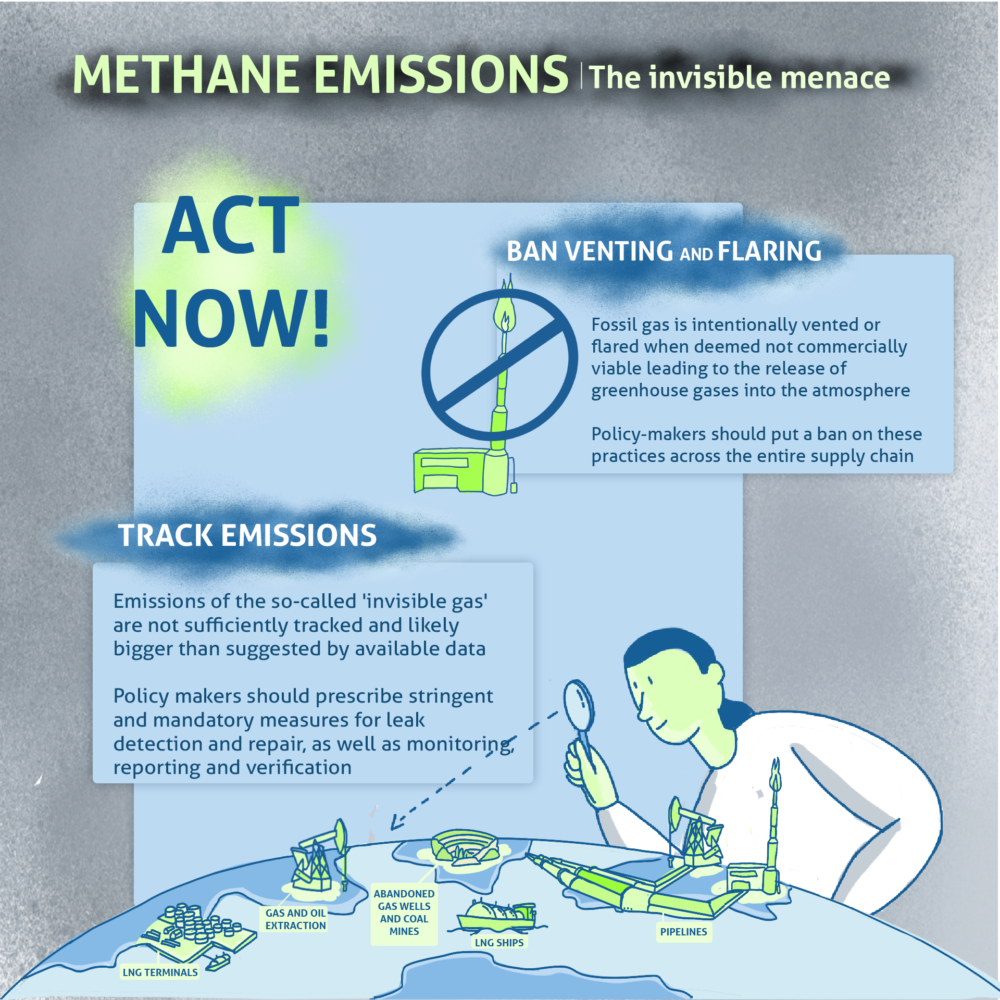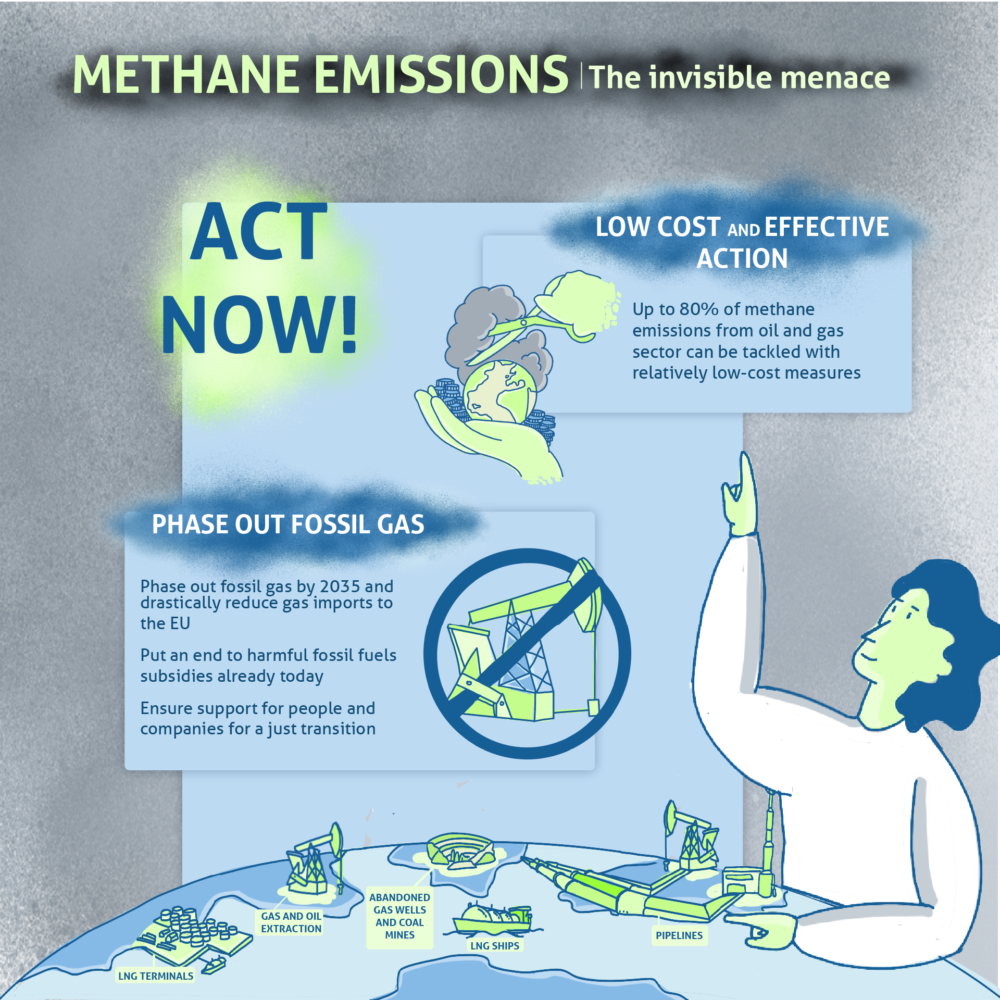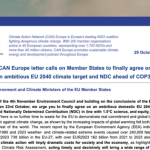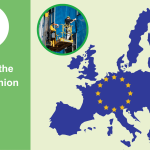Emissions of methane, a potent greenhouse gas, have far too long remained overlooked. The Intergovernmental Panel on Climate Change (IPCC) reports that anthropogenic methane emissions are likely responsible for 0.5 °C of warming. It also concluded that reaching a sustainable mitigation pathway to 1.5 °C can only be achieved with simultaneous deep reductions of carbon dioxide and all non-carbon dioxide climate forcing emissions, including short-lived climate pollutants such as methane.
Methane concentration in the atmosphere has more than doubled since pre-industrial times. There is strong evidence that the increase is due to growth in anthropogenic emissions rather than slower atmospheric removal rate processes or increased natural emission sources. In particular, it appears that increases are due to fossil fuel-related activities and agricultural and waste sources.
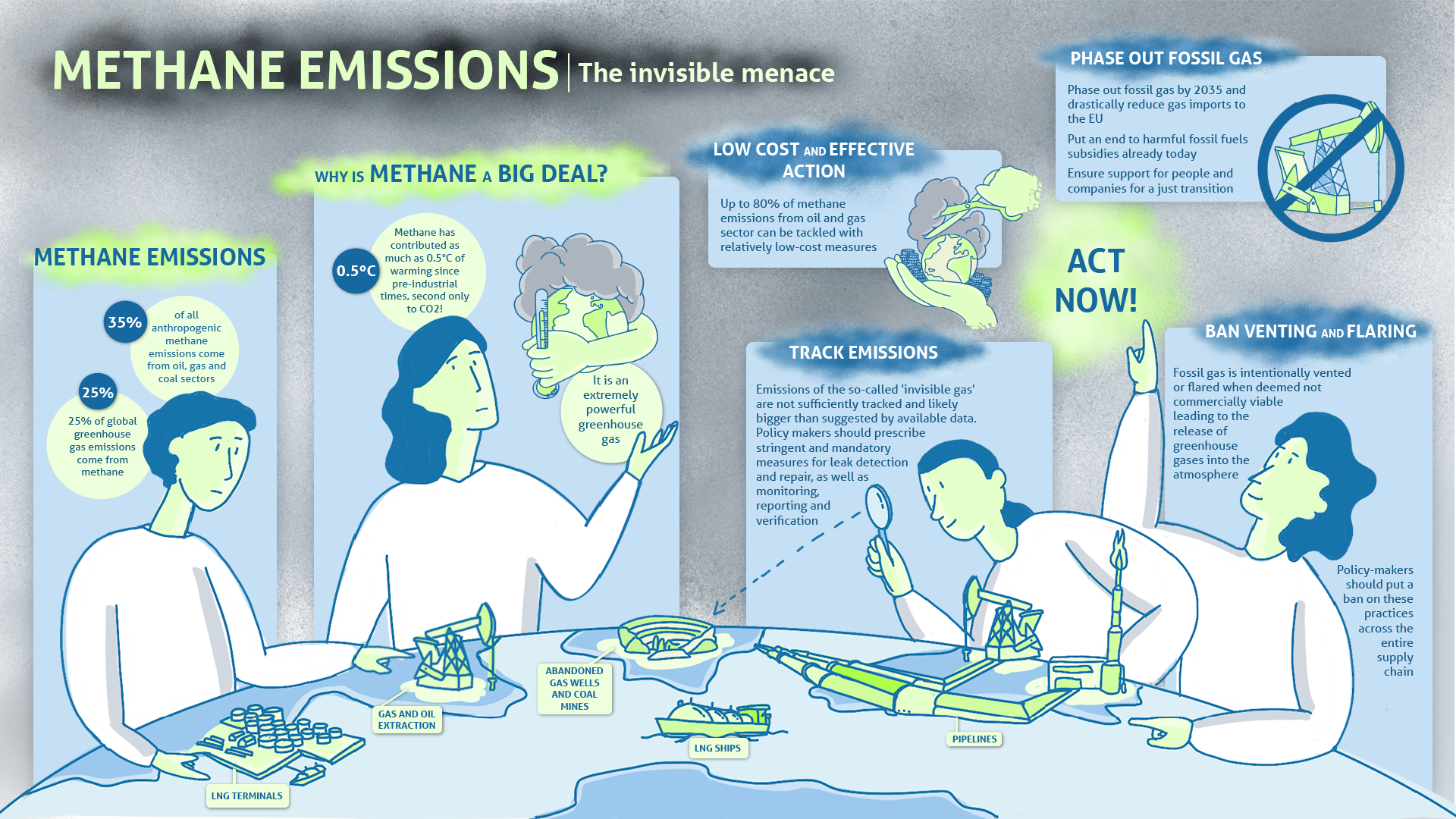
While measures to mitigate methane emissions are an important contribution to slow climate change, EU Member States must adopt, in parallel, very ambitious phase-out plans for oil, coal and gas. Any methane reduction measure that fails to be linked to a fossil gas phase-out is inadequate to lead to an overall reduction of greenhouse gases. The EU, as a major fossil gas import region (80-85% of the gas consumed in the block), should take decisive actions on both, working towards a fossil gas phase-out by 2035 while eliminating methane emissions across the entire supply chain.
Where does methane leak in the fossil gas sector?
Methane emissions from fossil fuels account for roughly 35% of all anthropogenic methane emissions. In particular, 23% of all anthropogenic methane emissions are ascribable to the oil and gas sector and 12% to the coal sector. Methane emissions from the fossil gas sector occur across the entire supply chain. That is because of both voluntary and involuntary releases of methane in the atmosphere. An example of the former is when certain maintenance works are carried out on gas pipelines that require a section of a pipeline to be emptied. If the fossil gas it transports is deemed commercially unviable, it will be released into the atmosphere. Since fossil gas is almost exclusively made of methane, large amounts of the climate polluting gas end up in the atmosphere contributing to global warming. Examples of involuntary discharges of methane in the atmosphere include equipment malfunctioning and accidents, and more in general, non-programmed discharges of fossil gas into the atmosphere.
Methane emissions from fossil gas occur across the entire supply chain, including during the pre-production phase (e.g. from hydraulic fracturing and well completion), the extraction phase (e.g. from fugitive emissions, equipment venting and workovers), the gathering and processing phases (e.g. from equipment venting and leaks), the transmission and storage phases (e.g. from compressors venting and leaks, pipework leaks, and storage site venting and leaks), the distribution phase (e.g. from pipework leaks, metering and regulating station leaks and vents, and customers meter leaks and vents), and the use phase (e.g. because of the incomplete combustion of fossil gas in boilers). Furthermore, several abandoned oil and gas wells and coal mines continue to emit large quantities of methane gas long after their decommissioning when not properly sealed up.
The solutions
However, a large share of methane emissions from the energy sector can be avoided at no or relatively low cost. The International Energy Agency estimated that around 40% of methane emissions from oil and gas can be avoided at no net cost. Similarly, the United Nations Environment Programme estimated that 60–80% of the total methane emissions from the oil and gas sector and 55–98% from the coal sector can be reduced through relatively inexpensive measures.
Several measures are already available to avoid these emissions. These include leak detection and repair (LDAR) measures, with detection to be performed as frequently as possible and ideally continuously and repairs to be carried out promptly after leaks are discovered. LDAR measures will inform and strengthen the currently weak Measuring, Reporting, and Verification (MRV) across the fossil fuel sector. Other measures include the ban of routine venting and flaring (BRVF) practices when these are not performed in the context of emergency situations but rather because of lacking incentives (e.g., commercially not attractive and absence of regulations) to recover the fossil gas.
Furthermore, effective sealing of decommissioned oil and gas wells and coal mines can also contribute to reducing methane emissions from these sources. Last but not least, the most effective way to reduce methane emissions is to keep fossil fuels underground, halting their extraction and new exploration. This also requires speeding up the energy transition toward a 100% renewable-based energy system.
Next steps to tackle methane emissions
In October 2020, the European Commission presented its EU strategy to reduce methane emissions. An own-initiative report from the European Parliament on curbing methane emissions will be voted in the plenary on Thursday, 21 October. Members of the European Parliament have already included in this report an appeal to phase out fossil fuels, a first in EU legislation.
At the international level, the UN Environmental Program will launch their International Methane Emissions Observatory (IMEO), slated for the end of this month at the G20. The Observatory will be tasked with processing, aggregating, and publishing data on methane emissions. Similarly, in the context of the upcoming UN Climate Change Conference (COP 26), the EU and the US will launch the Global Methane Pledge, an international initiative to reduce global methane emissions.
These set the scene for later this year when the European Commission aims to unveil its legislative proposal to reduce methane emissions as part of the ‘Fit for 55’ climate and energy legislative package.
The Commission should undoubtedly strengthen the European Parliament’s proposals on LDAR, MRBV and BRVF and abandoned oil and gas wells and coal mines. In parallel to that, it should also take the EP’s proposal on phasing out fossil fuels a step further and ensure that the EU is set on a pathway to phase out coal by 2030 and fossil gas by 2035. Finally, to tackle the global dimension of the problem and the EU’s situation as a major fossil gas importer, it is of utmost importance that methane leakages are dealt with across the entire supply chain, not only within the European Union but also outside European borders.
